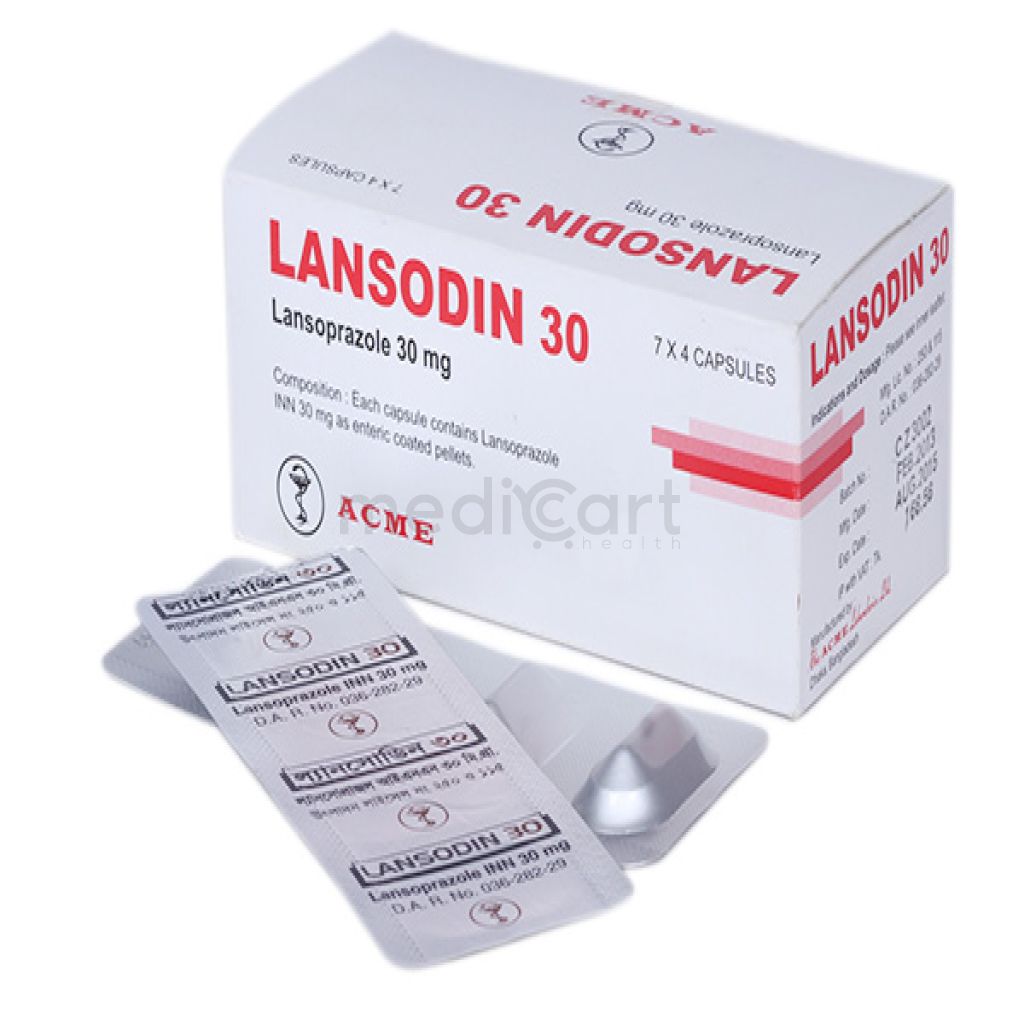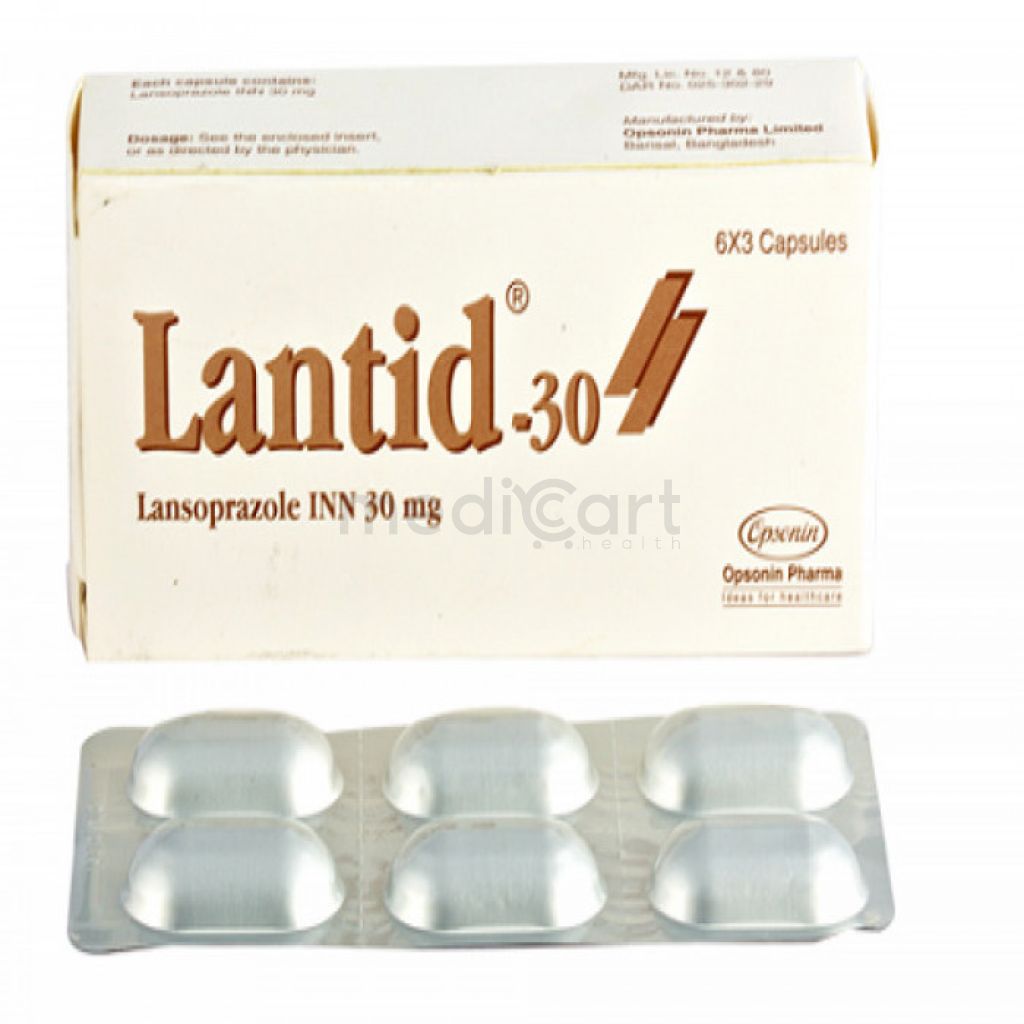

Lansodin 30mg
Capsule
Pack Size :
4 capsule x 1 strip
Generics :
Lansoprazole
Manufacturer :
Acme Laboratories Ltd.
Best Price *
TK
507.36
* Delivery will be done in Dhaka city only.
More Information About - Lansodin 30mg
Description
Generic Name
LansoprazolePrecaution
Hepatic impairment. Gastric malignancy should be ruled out. Pregnancy and lactation. Lactation Risk Summary There is no information regarding presence of lansoprazole in human milk, effects on breastfed infant, or on milk production; however, lansoprazole and its metabolites are present in rat milk; developmental and health benefits of breastfeeding should be considered along with mother?s clinical need for therapy and any potential adverse effects on breastfed child from treatment or from underlying maternal condition.Indication
Peptic ulcer, H.pylori infection, Gastro-oesophageal reflux disease, Hypersecretory conditions, Acid-related dyspepsia, NSAID-induced ulcers, Erosive oesophagitisContra Indication
Hypersensitivity.Dose
N/ASide Effect
1-10% Headache (3-7%),Diarrhea (1-5%),Constipation (1-5%),Nausea (1-3%),Abdominal pain (1-3%) <1% Anxiety,Angina,Palpitations,Syncope,Edema,Anorexia,Dry mouth,Tenesmus,Flatulence,Melena,Myalgia,Tinnitus,Allergic reactionPregnancy Category
Name : Not Classified
Description
FDA has not yet classified the drug into a specified pregnancy category.Mode of Action
Lansoprazole is a substituted benzimidazole, and is also known as PPI due to its property to block the final step of acid secretion by inhibiting H+/K+ ATPase enzyme system in gastric parietal cell. Both basal and stimulated acid are inhibited.Interaction
Increased risk of hypomagnesaemia w/ diuretics and digoxin. May decrease plasma concentration of erlotinib, dasatinib and lapatinib. May decrease the bioavailability of itraconazole and ketoconazole. May increase plasma concentration of cilostazol and methotrexate. Reduced bioavailability w/ antacids and sucralfate. Potentially Fatal: May decrease serum levels and pharmacological effects of rilpivirine and atazanavir.Pregnancy Category Note
Pregnancy Available data from published observational studies overall do not indicate an association of adverse pregnancy outcomes with lansoprazole treatment; estimated background risk of major birth defects and miscarriage for the indicated populations are unknown Available data from published observational studies failed to demonstrate an association of adverse pregnancy-related outcomes and lansoprazole use; methodological limitations of these observational studies cannot definitely establish or exclude any drug-associated risk during pregnancy No adverse effects on embryo-fetal development occurred in studies performed in pregnant rats at oral lansoprazole doses up to 150 mg/kg/day (40 times the recommended human dose [30 mg/day] based on body surface area) administered during organogenesis and pregnant rabbits at oral lansoprazole doses up to 0 mg/kg/day (16 times the recommended human dose based on body surface area) administered during organogenesis Lactation There is no information regarding presence of lansoprazole in human milk, effects on breastfed infant, or on milk production; however, lansoprazole and its metabolites are present in rat milk; developmental and health benefits of breastfeeding should be considered along with mother?s clinical need for therapy and any potential adverse effects on breastfed child from treatment or from underlying maternal conditionAdult Dose
Oral Peptic ulcer Adult: 30 mg once daily in the morning given for up to 4 wk (duodenal ulcer) or for up to 8 wk (gastric ulcer). Maintenance: 15 mg/day. Zollinger-Ellison syndrome Adult: Initially, 60 mg once daily in the morning and adjust as required. Daily doses >120 mg should be given in 2 divided doses. Acid-related dyspepsia Adult: 15-30 mg once daily in the morning for 2-4 wk. Gastro-oesophageal reflux disease Adult: 15-30 mg once daily in the morning for 4-8 wk. Maintenance: 15-30 mg once daily according to response. Prophylaxis of NSAID-induced ulcers Adult: 15-30 mg once daily in the morning. H.pylori infection Adult: 1-wk triple therapy: 30 mg bid combined w/ clarithromycin 500 mg bid and amoxicillin 1 g bid or combined w/ clarithromycin 250 mg bid and metronidazole 400 mg bid. Erosive oesophagitis Adult: 30 mg once daily in the morning for up to 8 wk, additional 8 wk if not healed. Maintenance: 15 mg once daily. NSAID-associated ulceration Adult: 30 mg once daily in the morning for 4-8 wk. Elderly: No dosage adjustment needed. Hepatic impairment: Severe: Max: 30 mg/day.Child Dose
Oral Gastro-oesophageal reflux disease 1-11 yr <30 kg: 15 mg once daily in the morning for up to 12 wk; >30 kg: 30 mg once daily in the morning for up to 12 wk. May increase doses up to 30 mg bid if patient is still symptomatic after 2 or more wk of treatment. 12-17 yr 15 mg once daily for up to 8 wk. Erosive oesophagitis 1-11 yr <30 kg: 15 mg once daily in the morning for up to 12 wk; >30 kg: 30 mg once daily in the morning for up to 12 wk. May increase doses up to 30 mg bid if patient is still symptomatic after 2 or more wk of treatment. 12-17 yr 30 mg once daily for up to 8 wk.Renal Dose
Renal impairment: No dosage adjustment needed.Administration
Should be taken on an empty stomach. Take before meals.Disclaimer
The information provided herein are for informational purposes only and not intended to be a substitute for professional medical advice, diagnosis, or treatment. Please note that this information should not be treated as a replacement for physical medical consultation or advice. Great effort has been placed to provide accurate and comprehensive data. However, Medicart along with its authors and editors make no representations or warranties and specifically disclaim all liability for any medical information provided on the site. The absence of any information and/or warning to any drug shall not be considered and assumed as an implied assurance of the Company.






